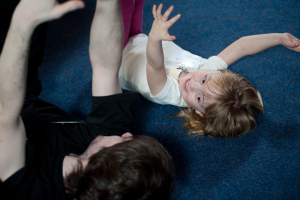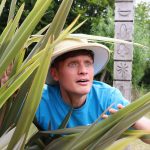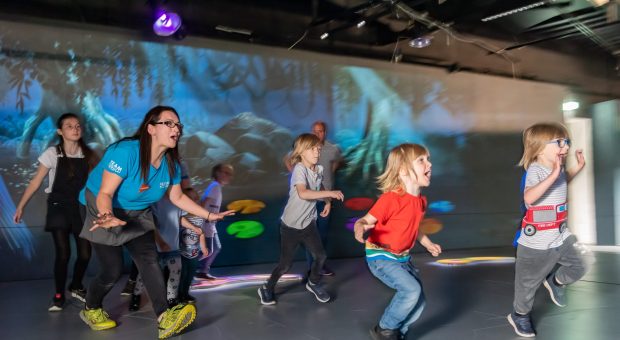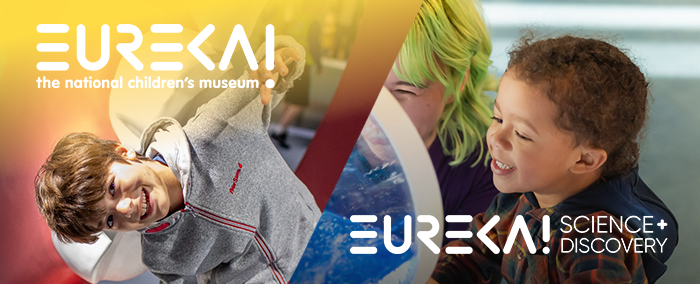Like many families with children who have disabilities, children with autism and their parents, siblings and carers face a number of barriers to visiting and getting the most out of museums and attractions.
From queues, to negative stimuli, to the impact on and views of others, many are nervous about taking children with disabilities on days out. Unfortunately, this means that they usually end up being excluded from some excellent cultural and educational experiences that help enhance family life and improve well-being.
Here at Eureka! The National Children’s Museum we aim to be as inclusive as possible to all children and families. We want to ensure that it is a place where everyone feels comfortable and can enjoy quality time together playing and learning. However, as we are a hands-on, multi-sensory environment which can be busy and noisy on some days, this can create additional challenges for children with autism, that can only be overcome with a specialist approach.
Our recent ‘Break to Play’ project was designed to pilot ways for families of children with autism to fully experience museum-based activities together – and also help them enjoy playing together at home.
We worked with 11 families over two six week periods offering over 240 hours of support. It was a great success but also taught us a lot about how we and other museums and attractions can support them. Here are our 10 tips for working with autistic children and their families
1. Do your research into the issues faced by children with autism and their families
Before embarking on the ‘Break to Play’ project we had limited expertise in the challenges that children with autism and their parents, carers and siblings face. We had to do a lot of research into the barriers they come up against and the challenges to overcoming them so that we could design a programme that would deliver results in the long term. We soon learnt that there was no ‘quick fix’ approach and that we needed to create something that built slowly and gave families the time, space and resources to deal with issues gradually.
2. Work with partners with autism expertise
Not only did we do our research, we partnered with experts who had experience and existing relationships with children with autism and their families to tap into their expertise and networks. We worked closely with the project funder Calderdale Aiming Higher for disabled children, Calderdale Council’s Specialist inclusion team, the Calderdale Parent and Carers Council and the National Autistic Society to ensure that we were addressing their wider goals.
3. Find a strong project leader who children and families can relate to
Next, we recruited a project leader who would take ownership of the project and work closely with the families involved at each stage. It was essential that the families had a point of contact and someone who understood what they were going through. Our project leader was extremely experienced both professionally and personally which gave her a unique insight into the sorts of issues they faced.
4. Secure strong leadership from the organisation for breaking down barriers faced by families
However, we didn’t rely solely on the project leader to run Break to Play. We wanted the project to be part of our mission and long term aspirations, which meant that strong leadership and support from the senior management team at the museum was really important.
5. Give museum staff specialist training in supporting children with autism and their families
It goes without saying that staff involved in the project needed to be trained in the specialist needs of the families they were working with. We were very lucky to be able to work with the Calderdale Parent and Carers Council and the National Autistic Society who provided key specialist knowledge and support to do this.
6. Create a dedicated space for the children and their families that is part of the museum experience
Although we recognised the need for providing families with their own dedicated space where they could focus on specialist activities, we wanted to make this very much part of the overall museum experience. In order to overcome sensory barriers with some interactive exhibits, we tackled one activity in one small part of the museum at a time.
7. Personalise the museum experience for families with different needs
There is no one size fits all approach to supporting the learning needs of children with autism or indeed any other disability. Furthermore, every individual family has different needs. The Break to Play project allowed us to build close relationships with a small number of families and understand what specific issues they face. For example, there was one child who disliked the smell and touch of paint but loved trucks. We slowly worked with him to introduce paint into play activities by encouraging him to use toy trucks to make patterns. By the end of the programme, he was able to get stuck in with painting without any problems.
8. Get families facing similar issues together
Families on the Break to Play programme benefited from spending time and networking with other families. This friendship and support helped their emotional health and well-being and gave them the opportunity to share ideas and learn from each other’s experiences.
9. Evaluate success
As with any project, it’s important to build in evaluation measures from the beginning so that you can measure its success. With an experimental project like Break to Play, the key thing was to get ongoing, anecdotal feedback from the families involved. Although the overall aim was to break down barriers for families of children with autism in being able to access museums and attractions, we were realistic about what we could achieve with this pilot project. We wanted the families to go away with some things that they could build on over time by increasing their confidence and self esteem. We also evaluated the success of the programme in terms of the skills our staff gained and improvements made at the museum based on our experiences.
10. Share your experiences of working with families with disabilities
A key part of the evaluation of our Break to Play programme was to identify what we could have done differently and how it could be built on and expanded. I recently gave a talk at a conference on the Break to Play project and many delegates from the museums sector came up to me afterwards to say how brave it was of us to try it. We want to work with other local authorities, museums and attractions to help families with children with disabilities access cultural and learning facilities in their communities.
Off the back of the success of ‘Break to Play’ we are about to start work on a three year project working with families with children with disabilities across Yorkshire and beyond funded by the Esmee Fairburn Foundation. We would love to hear from those working with families facing barriers to accessing museums and attractions because of disabilities to share experiences and gain a greater understanding of what we can do to help.
Eureka! Break to Play evaluation report for more information.




 By: Darren
By: Darren
 By: Ellie Shepherd
By: Ellie Shepherd